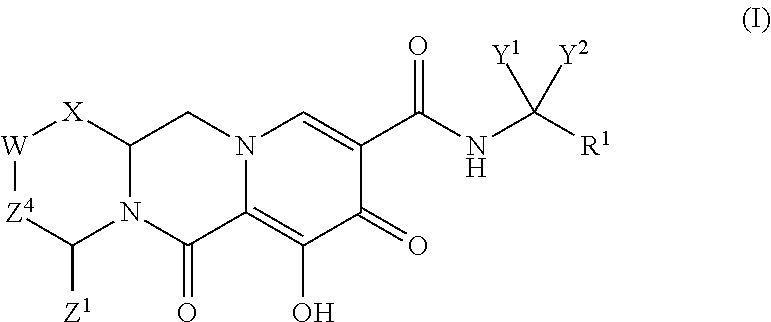Polycyclic-carbamoylpyridone compounds and their pharmaceutical use
a polycyclic carbamoylpyridone and compound technology, applied in heterocyclic compound active ingredients, drug compositions, biocides, etc., can solve the problems of complex decisions regarding the treatment of hiv infected patients, limited usefulness of strains, and major public health problems, so as to inhibit the activity of hiv integrase and reduce the effect of hiv replication
- Summary
- Abstract
- Description
- Claims
- Application Information
AI Technical Summary
Benefits of technology
Problems solved by technology
Method used
Image
Examples
example 1
Preparation of Compound 1
N-(2,4-difluorobenzyl)-8-hydroxy-7,9-dioxo-3,4,5,7,9,13,13a-octahydro-2,5-methanopyrido[1′,2:4,5]pyrazino[2,1-b][1,3]oxazepine-10-carboxamide
[0186]
Step 1
[0187]1-(2,2-dimethoxyethyl)-5-methoxy-6-(methoxycarbonyl)-4-oxo-1,4-dihydropyridine-3-carboxylic acid (1-A, 0.300 g, 0.95 mmol), prepared as described in WO2011 / 119566 A1, was evaporated once from dry toluene, suspended in acetonitrile (4 mL) and treated with N,N-diisopropylethylamine (DIPEA) (0.329 mL, 1.90 mmol), 2,4-difluorobenzylamine (0.125 mL, 1.05 mmol) and HATU (0.433 g, 1.14 mmol). The reaction mixture was stirred for 10 minutes and concentrated. The residue was purified by flash chromatography on silica gel (10 to 60% ethyl acetate:dichloromethane) to afford the compound methyl 5-(2,4-difluorobenzylcarbamoyl)-1-(2,2-dimethoxyethyl)-3-methoxy-4-oxo-1,4-dihydropyridine-2-carboxylate, 1-B. 1H-NMR (400 MHz, DMSO-d6) δ 10.28 (t, J=6.0 Hz, 1H), 8.46 (s, 1H), 7.42 (dd, J=15.4, 8.6 Hz, 1H), 7.24 (m, 1H), ...
examples 2 and 3
Preparation of Corn pounds 2 and 3
[0190](2R,5S,13aR)—N-(2,4-difluorobenzyl)-8-hydroxy-7,9-dioxo-2,3,4,5,7,9,13,13a-octahydro-2,5-methanopyrido[1′,2′:4,5]pyrazino[2,1-b][1,3]oxazepine-10-carboxamide (2) and (2S,5R,13aS)—N-(2,4-difluorobenzyl)-8-hydroxy-7,9-dioxo-2,3,4,5,7,9,13,13a-octahydro-2,5-methanopyrido[1′,2′:4,5]pyrazino[2,1-b][1,3]oxazepine-10-carboxamide (3)
[0191]Compound I (16 mg) was separated by chiral HPLC using Chiralpak AS-H with 100% ethanol as eluent to afford Compounds 2 and 3 in enantiomerically enriched form. For Compound 2: LCMS-ESI+ (m / z): [M+H]+ calculated for C21H20F2N3O5: 432.14; found: 432.2, Chiral HPLC retention time=4.50 minutes (Chiralpak AS-H, 150×4.6 mm, 1 mL / min EtOH). For Compound 3: LCMS-ESI+ (m / z): [M+H]+ calculated for C21H20F2N3O5: 432.14; found: 432.2, Chiral HPLC retention time=6.84 minutes (Chiralpak AS-H, 150×4.6 mm, 1 mL / min EtOH). 1H-NMR (400 MHz, DMSO-d6) δ 12.45 (br s, 1H), 10.35 (t, J=5.8 Hz, 1H), 8.44 (s, 1H), 7.37 (dd, J=15.2, 8.4 Hz, 1...
example 4
Preparation of Compound 4
(1S,4R)—N-(2,4-difluorobenzyl)-7-hydroxy-6,8-dioxo-3,4,6,8,12,12a-hexahydro-2H-1,4-methanopyrido[1′,2′:4,5]pyrazino[1,2-a]pyrimidine-9-carboxamide
[0195]
[0196]Methyl 5-(2,4-difluorobenzylcarbamoyl)-1-(2,2-dihydroxyethyl)-3-methoxy-4-oxo-1,4-dihydropyridine-2-carboxylate (1-C, 0.12 mmol in 0.53 mL of 9:1 acetonitrile:acetic acid containing 0.002 mL methanesulfonic acid) was treated with acetonitrile then (R)-pyrrolidin-3-amine (0.032 mL, 0.36 mmol). The reaction mixture was capped and heated to 90° C. for 5.5 hours. After cooling, the mixture was partitioned between dichloromethane and sodium bicarbonate (1M aqueous). The organic layer was separated and the aqueous was extracted again with ethyl acetate. The combined organic layers were dried over sodium sulfate (anhydrous), filtered and concentrated. The residue was dissolved in acetonitrile (1 mL), treated with magnesium bromide (0.022 g, 0.12 mmol), capped and heated to 50° C. for 10 minutes. After cooling ...
PUM
| Property | Measurement | Unit |
|---|---|---|
| Therapeutic | aaaaa | aaaaa |
| Bond | aaaaa | aaaaa |
Abstract
Description
Claims
Application Information
 Login to View More
Login to View More - R&D
- Intellectual Property
- Life Sciences
- Materials
- Tech Scout
- Unparalleled Data Quality
- Higher Quality Content
- 60% Fewer Hallucinations
Browse by: Latest US Patents, China's latest patents, Technical Efficacy Thesaurus, Application Domain, Technology Topic, Popular Technical Reports.
© 2025 PatSnap. All rights reserved.Legal|Privacy policy|Modern Slavery Act Transparency Statement|Sitemap|About US| Contact US: help@patsnap.com



